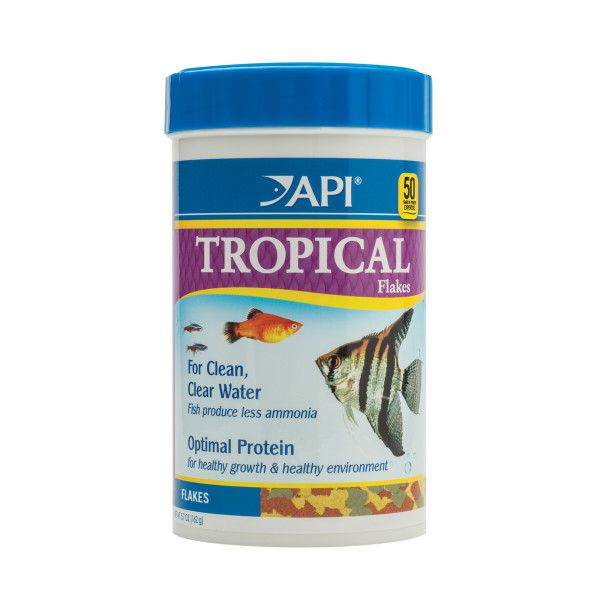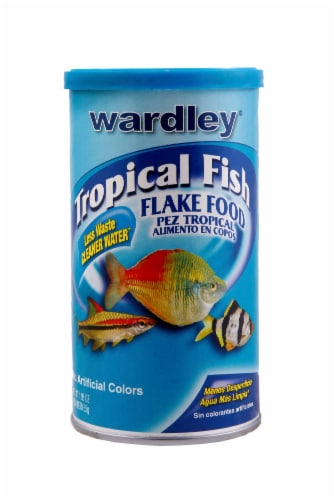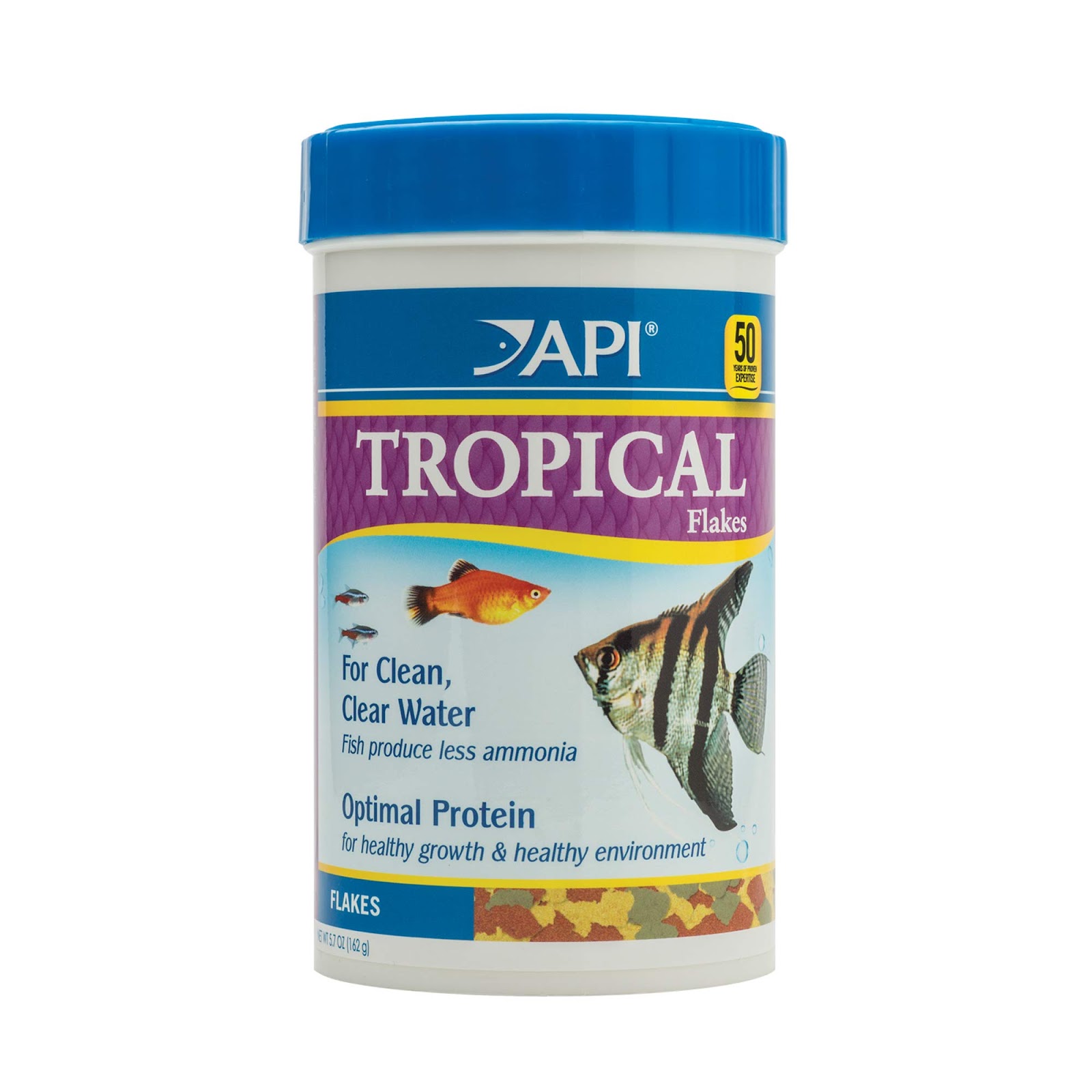Tropical fish food is made to match what freshwater and marine aquarium fish eat.. It often comes in flakes, pellets, or freeze-dried options.
Tropical fish do best when they eat food that keeps them healthy, colorful, and full of energy. This means they need food with lots of proteins, vitamins, and minerals. There are many types of food for different kinds of fish, each with its own needs and ways of eating.
Quality tropical fish food helps maintain clean water conditions by minimizing waste. Picking the correct food for your underwater friends is super important. It impacts how they grow and stay healthy, plus the whole aquarium setup. Make sure to feed them at the same times every day and give them the right amount. That way, your tropical fish will live happily in a balanced environment.

Credit: apifishcare.com
The Importance Of Quality Nutrition
A balanced diet is key for tropical fish health. Like humans, fish need a range of nutrients to thrive. Quality food means lively fish with bright colors. It also means less waste, keeping the tank clean.
Balanced Diet For Health
Fish require a variety of food to stay healthy. A balanced diet includes:
- Proteins for growth.
- Vitamins for immune system strength.
- Fibers for digestion.
Feeding them the same food every day can lead to deficiencies. Thus, it’s vital to mix flakes, pellets, frozen, and live food.
Impact Of Nutrition On Color And Growth of Tropical Fish Food
Good food affects fish color vibrancy. Nutrients like carotenoids enhance red, orange, and yellow hues. For growth, high-quality proteins are essential.
Here’s a table to summarize:
| Nutrient | Color Impact | Growth Impact |
| Carotenoids | Brighter colors | — |
| Proteins | — | Faster growth |
Choose foods that support both color and growth for the best outcomes.
Table of Contents
Key Nutrients In Tropical Fish Food
When choosing the right food for tropical fish, key nutrients matter. These nutrients ensure that your fish are healthy, vibrant, and active. Every kind of fish has its own special needs, but there are some things they all need to stay healthy. Here, we’ll talk about the important stuff that every tropical fish food should have for a good diet.
Proteins And Amino Acids
Proteins are the building blocks of a healthy fish diet. They are essential for growth, repair, and vitality. Find food with lots of proteins and a mix of amino acids, which are what proteins turn into when they break down. Amino acids support metabolism and are necessary for young fish to grow.
- Include fish or shrimp meal for a protein-rich diet.
- Ensure the food has both essential and non-essential amino acids.
- Opt for high-quality, easily digestible proteins that minimize waste.
Vitamins And Minerals of Tropical Fish Food
The vitamins and minerals in tropical fish food help with many body functions. Vitamins like A, C, D, E, and K support vision, immune response, bone health, and cell protection. Minerals, including calcium, magnesium, and potassium, maintain water balance and strengthen bones. Let’s break down these essential nutrients:
| Vitamin | Benefits |
| Vitamin A | Boosts vision and growth. |
| Vitamin C | Strengthens the immune system. |
| Vitamin D | Crucial for calcium absorption. |
| Vitamin E | Protects cells from damage. |
| Vitamin K | Essential for blood clotting. |
Ensure a mix of these vitamins in your fish’s diet. Along with proteins and amino acids, vitamins and minerals keep fish strong and full of life.
Types Of Tropical Fish Food
Feeding tropical fish the right food keeps them colorful, active, and healthy. There are many types of tropical fish food. These cater to the diverse diets of different fish species. Here is a look at the most common types: flakes, pellets, frozen, and live foods.
Flakes And Pellets
Flakes and pellets are popular and convenient. They suit a variety of tropical fish. Both are easy to store and pack a lot of nutrients.
- Flakes: Ideal for surface feeders. They dissolve slow, so fish have time to eat them.
- Pellets: Perfect for bottom feeders. They sink and come in different sizes for big or small fish.
| Food Type | Best For | Nutrient Content |
| Flakes | Surface Feeders | Vitamins, Minerals |
| Pellets | Bottom Feeders | Protein, Fiber |
Check the label for the right blend for your fish. Some foods are for color enhancement or growth.
Frozen And Live Foods
Frozen and live foods provide variety. They keep fish excited about meals.
- Frozen Foods: These are preserved and easy to store. They often include bloodworms, brine shrimp, and daphnia.
- Live Foods: They ensure a natural diet. They are great for fish health. Consider live brine shrimp or worms.
Alternate between flakes or pellets and frozen or live foods. This ensures a balanced diet.
Feeding Techniques And Frequency
Correct feeding is crucial for tropical fish health. This section dives into when and how often to feed your aquatic friends.
Optimal Feeding Times
Tropical fish thrive on routine. Feeding them at the same times each day is best. Mornings and evenings are ideal. Fish are more active during these times. This aligns with their natural feeding patterns.
- 7-9 AM: Start the day with a morning meal.
- 6-8 PM: Conclude with an evening feed.
Avoiding Overfeeding
Overfeeding leads to health issues and polluted tanks. Offer only what your fish can consume in two to three minutes. Follow this rule to prevent problems.
| Fish Size | Amount | Frequency |
| Small Fish | Pinch of Flakes | Twice Daily |
| Medium Fish | Two Pinches of Flakes or Pellets | Twice Daily |
| Large Fish | Appropriate Portion of Pellets | Once Daily |
Considerations For Specific Species
Fish enthusiasts know that feeding tropical fish isn’t a one-size-fits-all affair. Specific species demand specialized diets. Knowing what your fish like to eat and what is healthy is crucial, regardless of their fussiness. Now, let’s talk about the different things to think about for tropical fish, based on how they eat.
Carnivorous Fish
Meat eaters of the aquatic world, carnivorous fish thrive on protein-rich diets. Their feeding frenzy must include the following:
- Live food like bloodworms or brine shrimp
- Frozen treats to stimulate hunting instincts
- Specialized pellets or flakes that cater to meat-loving species
Herbivorous Fish
Leaf lovers of the tank, herbivorous fish require greens for optimal health. They should have lots of on their plates:
- Algae wafers for a well-rounded meal
- Chopped veggies such as zucchini or lettuce
- Veggie-based flakes to ensure daily nutrition
Omnivorous Fish
Those with a varied palette, omnivorous fish enjoy the best of both worlds:
- A mix of animal proteins and vegetation
- Varied diet including pellets and fresh food
- Balance is key; too much of one can lead to health issues
Special Diets For Breeding Or Aging Fish
Like people, fish have different needs at various stages of life. Breeding pairs and aging swimmers may need:
| Life Stage | Dietary Needs |
| Breeding Fish | High-protein food to promote egg production |
| Aging Fish | Easily digestible food to accommodate slower metabolism |
Evaluating Commercial Fish Foods
For tropical fish lovers, choosing the right food is key. Evaluating fish foods is important but can be tricky. With the right info, aquarium owners can pick good food for their fish.
Reading Labels And Understanding Ingredients
Diving into the world of fish food begins with label literacy. Each label provides a wealth of information. It is key to ensuring your fish receive a balanced diet.
- Protein sources should be at the top of the ingredients list, indicating high content. Look for meals derived from fish, shrimp, or algae.
- Fats offer energy. They should appear in moderation on the label.
- Vitamins and minerals should be present as well, citing a well-rounded diet.
- A list of specific ingredients rather than ‘fish meal’ or ‘marine protein’ is a sign of quality.
A table can clarify the ideal composition of Tropical fish food :
| Component | Desired Presence in Food |
| Proteins | High |
| Fats | Moderate |
| Vitamins & Minerals | Varied |
Avoiding Harmful Additives
Not all ingredients in tropical fish food promote health. Certain additives pose a threat to your aquatic ecosystem.
Keep an eye out for these unwanted components:
- Artificial colors: They make food look appealing but offer no nutritional value.
- Preservatives: Some, like ethoxyquin, can be harmful over time.
- Wheat and soy fillers don’t offer much nutrition and can make the tank dirty.
Always opt for foods with fewer or no chemical additives. This choice supports fish longevity and a cleaner aquarium environment.
Selecting The Right Food For Your Fish
Feeding tropical fish is like choosing a meal for a family dinner. Every fish has a favorite dish. To keep your aquatic family happy and healthy, it’s essential to serve up the perfect menu. Let’s dive into what makes a meal fit for a fin!
Factors To Consider
Before you can pick the right food, think about these points:
- Nutrition: Like humans, fish need a balanced diet.
- Food Type: Options range from flakes to live food.
- Feeding Schedule: Consistent feeding times help fish thrive.
Fish Species
Different fish species required different diets:
| Fish Type | Preferred Diet |
| Herbivores | Plants and algae-based foods. |
| Omnivores | A mix of meat and vegetation. |
| Carnivores | Meat-based foods, sometimes live prey. |
Size And Age Of Fish
Fish size and age impact meal choices:
- Baby Fish need tiny, high-protein meals.
- Adult Fish enjoy a wider range of sizes and types.
Water Temperature
The water’s warmth affects digestion:
- Warm water speeds up metabolism.
- Colder water slows digestion.
- Adjust food quantity and frequency with temperature changes.

Credit: www.kingsoopers.com
Troubleshooting Common Feeding Issues
Figuring out what’s wrong with feeding tropical fish can sometimes be puzzling. If your colorful guppies or beta fish aren’t eating, it’s worrying. To solve problems, you must keep a close eye and understand common feeding issues.. Now, let’s see why these problems occur and find easy ways to keep your fish happy and healthy.
Fish Refusing To Eat: Identifying Underlying Causes And Solutions
When fish refuse to eat, the reasons can vary. Examining their environment for clues is key. Is your tank clean and well-filtered? Are water parameters like temperature and pH within ideal ranges? Stress often leads to loss of appetite, so ensure their habitat is serene.
- Verify water quality – check ammonia, nitrite, and nitrate levels.
- Observe for bullying – ensure all fish have ample space and hiding spots.
- Inspect for illness – look for signs like spots or lethargy, and isolate if needed.
Introducing varied, high-quality food, and feeding at regular intervals can tempt picky eaters. If you see no improvement, consult a vet specializing in aquatic animals.
Dealing With Fish Overeating Or Begging Behavior
Overeating can be as dangerous as not eating. Fish with bulging bellies are likely overindulging. Following feeding instructions is vital. Don’t overfeed, even if they beg.
| Issue | Solution |
| Fish racing to the top at feeding time | Adopt a consistent feeding schedule |
| Continuous begging whenever you’re near the tank | Feed only the recommended amount |
| Other pets fed nearby causing excitement | Feed fish separately to avoid overstimulation |
Part control and feeding frequency are vital. Most tropical fish thrive with two small feedings a day. If your fish beg for food, use a timer to feed them . This helps stop them from linking you with food.
Adapting Feeding Practices To Tank Environments
Every fish lover knows that a good diet is vital for a lively aquarium. But not all tank environments are the same, and neither are their residents’ dietary needs. Adjust feeding to fit each tank’s needs so all fish stay healthy and happy.
Community Tanks
Community tanks are bustling with diverse fish species. With such variety, picking the right food can be a challenge. A well-balanced diet is vital.
- Flake foods provide a balanced diet for many species.
- Algae wafers are excellent for herbivores.
- Protein-rich pellets cater to larger or carnivorous fish.
Think about where your fish eat: some at the top, some in the middle, and some at the bottom. All fish should get their food where they like to eat.
| Fish Type | Food Type | Feeding Zone |
| Top-feeders | Flakes | Surface |
| Mid-water Feeders | Pellets | Mid-water |
| Bottom Dwellers | Wafers | Bottom |
Aquascaped Tanks
In aquascaped tanks, beauty meets functionality. The lush landscape demands a careful feeding strategy to prevent excess waste.
- Feed small amounts to avoid overfeeding.
- Clean up uneaten food to prevent nutrient imbalance.
- Slow-sinking food allows fish to eat as it falls.
Precise feeding complements the stunning visuals of aquascaped tanks without compromising water quality.

Credit: www.amazon.com
Common Questions
What Is The Best Food For Tropical Fish?
Great food for tropical fish has flakes, pellets, and live or frozen options like brine shrimp. Ensure it’s high in nutrients and suited for your specific fish species. Regular feeding with appropriate portions maintains health and vitality.
How Often Should You Feed Tropical Fish?
Feed tropical fish in small amounts 1-2 times daily. Overfeeding can pollute the water and harm their health.
What Can Tropical Fish Eat Besides Tropical Fish Food?
Tropical fish like boiled veggies, fruit, and live or frozen brine shrimp. They can also eat bloodworms and daphnia instead of regular tropical fish food.
What Is The Best Tropical Fish To Eat?
The best tropical fish to eat is often considered to be the meaty and flavorful Mahi Mahi, also known as Dorado.
What Is Tropical Fish Food Made Of?
Tropical fish food usually made from fish, squids, and vitamins to keep fish healthy.
How much should you feed tropical fish?
Give your tropical fish food 2-3 times a day. Only give them what they can eat in a few minutes to avoid overfeeding and dirty tanks.
Can Tropical Fish Eat Human Food?
Some tropical fish might like cooked veggies and fruits such as zucchini and peas. But don’t replace their special fish food with human food.
Conclusion
Feeding your tropical fish the right diet is crucial for their health and vibrancy. Opt for high-quality, species-specific food to ensure they thrive in their aquatic home. Keep in mind, giving fish good food makes them lively and happy. If you learn to feed them right, they’ll reward you with bright colors.








Your article helped me a lot, is there any more related content? Thanks!